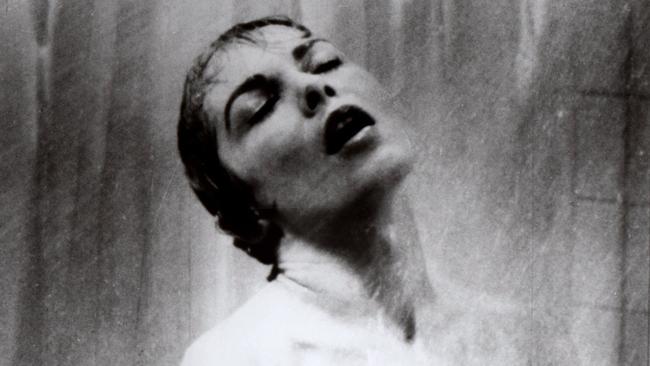Alfred Hitchcock’s Psycho scene in the frame for documentary
Alfred Hitchcock’s most famous scene, in the 1960 thriller Psycho, has become the subject of a film in itself.

There have been plenty of feature-length documentaries about the making of classic films, but 78/52 may be the first to focus on one classic scene. It could be the last, too — not because it isn’t bubbling with insights and information but because there are so few scenes that merit such a high level of attention.
The subject of Alexandre O. Philippe’s fascinating treatise is the appallingly ferocious murder scene in Alfred Hitchcock’s nerve-jangler, Psycho (1960). Marion Crane (played by Janet Leigh) is washing in a motel shower when someone — seemingly a woman — stabs her to death with a kitchen knife.
To cite just one sign of this sequence’s pop-cultural importance, an Australian indie band in the 1980s named itself The Shower Scene From Psycho. How many other film scenes have burned themselves so deeply into the collective consciousness that they have bands named after them?
According to 78/52, what attracted Hitchcock to Psycho in the first place was the audacity of killing off the ostensible heroine only 20 minutes into a film. Considering that Leigh was a much-loved superstar at the time, it was a twist no one could have predicted. Peter Bogdanovich, one of the documentary’s many high-profile interviewees, remembers the “sustained shriek” that rose from the audience when the film premiered in New York. What a blessing that Twitter wasn’t around in 1960 to spoil the surprise.
Other commentators weigh in with theories as to why the scene is so significant. Bret Easton Ellis, the author of American Psycho, proposes that the taboo-shattering violence and nudity marked the end of the conservative 1950s and the introduction of graphic horror-movie gore to mainstream cinema. Karyn Kusama, the director of Girlfight (2000) and Jennifer’s Body (2009), pronounces it “the first modern expression of the female body under assault”.
But while these sociopolitical ruminations are interesting enough, the documentary is at its best when it homes in on the technical aspects of putting together such a complicated, labour-intensive scene. (The reason for Philippe’s perplexing title is that the sequence incorporates 78 camera setups and 52 cuts.) Hitchcock knew all of the tricks of the trade. He used Hershey’s chocolate syrup for the blood that swirled down the plughole because it looked just right in black and white. He blocked the shower head’s central holes so the camera could point straight up at it without getting drenched. And when the time came to dub in the sounds of a knife hacking into human flesh, he listened to a tableful of melons being skewered before picking the one — a casaba — with the right balance of resistance and squishiness.
Not that Hitchcock was working alone. Rather than suggesting that the scene sprang fully formed from an auteur’s imagination, 78/52 starts with the pages of the Robert Bloch novel that were the basis of the scene.
Then comes a reading of Joseph Stefano’s detailed screenplay. Next we see the storyboards drawn by Saul Bass. But we are also reminded of the camera angles that those storyboards didn’t include.
As the documentary’s various commentators rewatch the scene, they all betray their professional biases. Bob Murawski, who edits Sam Raimi’s films, lauds the “American cut”, when an editor jumps to a close-up and then jumps closer still.
But the musicians in 78/52 contend that the scene would have been nothing without the violin screeches composed by Bernard Herrmann. Jamie Lee Curtis is on hand to praise the performance of Leigh, her mother.
But the film opens with an interview with Leigh’s body double, Marli Renfro, who was in most of the shots.
That is the most striking lesson taught by 78/52. Several of its contributors argue that the shower scene is the ultimate distillation of Hitchcock’s obsessions and the most searing demonstration of his filmmaking genius.
But it wouldn’t have become a phenomenon without a whole crowd of collaborators, all of them operating at the dizzying peak of their powers.
78/52 is streaming now on Netflix.
The Economist



To join the conversation, please log in. Don't have an account? Register
Join the conversation, you are commenting as Logout